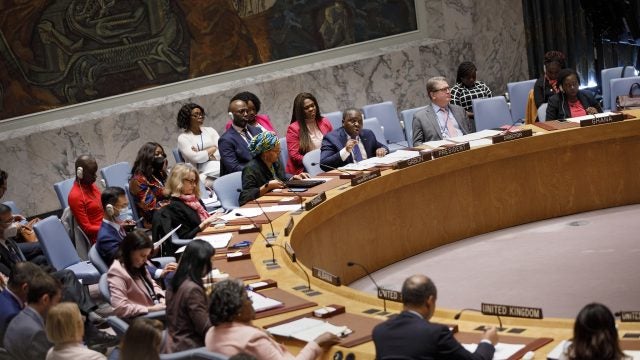The United States’ One-China policy has been at the center of recent controversy. Rebutting Beijing’s accusations that Washington is changing the status quo, US officials have stressed that the United States remains committed to the One-China policy, but their explanations of the policy have not always been complete or accurate. This article discusses recent developments in the One-China policy and how to interpret the United States’ silence on Taipei’s assertions of sovereignty and independence.
The dispute over Taiwan has been at the center of recent US-China tensions. One of the main areas of debate has been the United States’ adherence to its “One-China policy,” under which the United States recognizes Beijing as the government of China and maintains unofficial relations with Taiwan. Rebutting Beijing’s accusations that the United States is supporting Taiwan’s independence by having senior US officials visit the island, Washington has repeatedly stressed that the One-China policy has not changed and that the United States continues to oppose unilateral changes to the status quo. The “status quo” has not been formally defined, however, and neither has the “unofficial” character of US relations with Taiwan. In the past, this ambiguity helped both sides to obscure the fundamental differences between them. But amid recent tensions, those differences have been laid bare, leading some policymakers and policy analysts to question its continuing viability while others insist on its continuing importance. For the United States, the central issue is deciding on the limits and opportunities for deepening support for Taiwan at a time when Beijing poses an acute threat.
In recent years, US officials have explained the One-China policy in ways that are incomplete or even inaccurate. In addition to apparent gaffes (e.g., President Biden calling Taiwan independent; Biden saying Taiwan could decide for itself on independence; Biden referring to a mysterious “Taiwan agreement”; and Secretary Blinken calling Taiwan a country twice), the Biden administration has at times avoided firmly articulating the One-China policy. For example, in May 2022, the State Department’s fact sheet on US relations with Taiwan was revised to omit two statements: the United States acknowledges the Chinese position that Taiwan is part of China (found in the Shanghai Communiqué and the Normalization Communiqué); and the United States does not support Taiwan’s independence (found in the Arms Sales Communiqué). The second of those statements was eventually restored, but the first was not, demonstrating the Biden administration’s reluctance to fully explain US policy toward Taiwan.
US officials have also expressed the One-China policy in ways that do not reveal the United States’ clear position on the sovereignty of Taiwan. Echoing a similar statement by David Stilwell in August 2020, then-Pentagon spokesperson John Kirby stated in October 2021 that the United States took no position on the sovereignty of Taiwan. State Department spokesperson Ned Price issued a similar statement in September 2022. It is debatable as to how deliberate this choice of wording was, but it is still not the official policy. The United States has a position on the sovereignty of Taiwan: it is undetermined, as stated by President Truman on June 27, 1950. During the normalization of US-PRC relations, the United States resisted Beijing’s pressure to recognize Taiwan as part of China. One of the Six Assurances that the United States conveyed to Taiwan in August 1982 was that the United States “has not altered its position regarding sovereignty over Taiwan.” The United States never changed its position that Taiwan was undetermined, so it is not correct to say that the United States takes no position on Taiwan’s sovereignty. The difference between “no position” and “undetermined” may seem subtle, but it is significant. If the United States had no position, it could neither agree nor disagree with Beijing’s claim of sovereignty over Taiwan. Since the United States does have a position that Taiwan’s status is undetermined, it disagrees with Beijing: the United States does not consider Taiwan to be part of China.
In implementing the One-China policy, the United States has been silent after statements from Taipei that Washington does not agree with. Contrary to Beijing’s claim that it is “pro-independence,” the Tsai administration has adopted a moderate policy of stating that Taiwan does not need to declare independence because it is already an independent and sovereign state called the Republic of China (Taiwan). Tsai herself stated this position in a 2020 interview with the BBC, and the Presidential Office recently asserted Taiwan’s existing independence and sovereignty in response to Xi Jinping’s speech on Taiwan during the 20th Communist Party Congress. The United States has neither endorsed nor disputed Taipei’s position. US policy has been to oppose unilateral changes to the status quo, not unilateral interpretations of what the status quo is (which is what the Tsai administration’s official position amounts to). Similarly, the United States’ lack of recognition of Taiwan does not mean that the United States denies the existence of the Republic of China (Taiwan). Washington’s silence on these statements from Taipei is consistent with the One-China policy.
But there have been controversies surrounding the One-China policy that have seen US officials asserting their views openly. One of the most prominent sources of controversy centers on the policy of strategic ambiguity, under which the United States does not state whether or how it would intervene if Beijing uses force or coercion to take control of Taiwan (as opposed to strategic clarity, under which the United States would commit to defending Taiwan). In May 2022, President Biden said that strategic clarity was “the commitment we made” at some point in the past. The White House soon clarified that there had been no change in US policy; but Biden then made a similar statement in September, and in subsequent remarks, James Moriarty, the Chair of the American Institute in Taiwan (the United States’ de facto embassy), claimed that Biden’s statement was consistent with the Taiwan Relations Act.
The controversy on strategic ambiguity is closely related to disputes over how to interpret the Taiwan Relations Act. Subsection 2(2)(f) of the Taiwan Relations Act states that US policy is “to maintain the capacity of the United States to resist” Beijing’s potential use of force or coercion against Taiwan; it does not say that the United States will necessarily exercise that capacity. Subsection 3(3) says that in the event of a threat to Taiwan’s security, “the President and the Congress shall determine…appropriate action by the United States in response to any such danger” (emphasis added). This is weaker language than that of a formal alliance treaty, such as “will assist the Party or Parties so attacked by taking forthwith…such action as it deems necessary, including the use of armed force” (North Atlantic Treaty) and “declares that it would act to meet the common danger” (US-ROK Mutual Defense Treaty; US-Japan Treaty of Mutual Cooperation and Security; emphases added). In other words, the Taiwan Relations Act does not state that the United States will necessarily act or intervene if Beijing uses force or coercion against Taiwan, and this is what distinguishes the TRA from an alliance treaty.
There is evidence that the Biden administration recognizes that the Taiwan Relations Act is worded in a way that conveys strategic ambiguity. The version of the Taiwan Policy Act that was first introduced in the Senate in June 2022 included a proposed revision to the Taiwan Relations Act (in Subsection 201(a)(2)) that would have removed “to maintain the capacity of the United States,” leaving the policy as “to resist” Beijing’s potential use of force or coercion against Taiwan. This change would have formalized a shift from strategic ambiguity to strategic clarity; but amid reports that the Biden administration expressed reservations about the Taiwan Policy Act to the Senate Foreign Relations Committee, this provision was subsequently removed. Moreover, a new rule of construction was added (Section 1102) stating that “nothing in this Act may be construed as authorizing the use of military force or the introduction of United States forces into hostilities.” And in the administration’s National Security Strategy released in October 2022, the language on Taiwan follows that of the Taiwan Relations Act: “and we will uphold our commitments under the Taiwan Relations Act to support Taiwan’s self-defense and to maintain our capacity to resist any resort to force or coercion against Taiwan.” As far as official policy is concerned, strategic ambiguity is still in place, though Biden has clearly indicated his personal preference.
The US stance on the One-China policy is in transition. Although it has fixed elements, such as recognizing Beijing as the sole legal government of China and maintaining unofficial relations with Taiwan, those elements are written at a high level of abstraction. Such abstractions create room for interpretation on how to conduct the day-to-day diplomacy of US-Taiwan relations. The United States has periodically revised the implementation of the One-China policy in the interest of promoting peace and stability in the Taiwan Strait. It also has exercised its own discretion over how it chooses to interpret “unofficial” relations and the “status quo.” The question is how far the United States can revise its policy without leading to escalation. A balanced approach to this issue will involve both deductive and inductive elements. Deductively, Washington should decide what is logically consistent with its statements of policy in the Three US-China Joint Communiqués, the Taiwan Relations Act, and the Six Assurances. Inductively, Washington should weigh how Taipei, Beijing, and US allies are likely to react to potential changes in US policy. Of course, the United States will have to decide what is in its own interest, but that will require the United States not to take actions that will produce a response from Beijing that will threaten US interests—as conflict over Taiwan surely would.
. . .
James Lee is an Assistant Research Fellow at the Institute of European and American Studies at Academia Sinica (Taiwan) and an affiliated researcher of the University of California Institute on Global Conflict and Cooperation (IGCC).
Image Credit: Wikimedia Commons; Creative Commons Attribution-Share Alike 4.0



